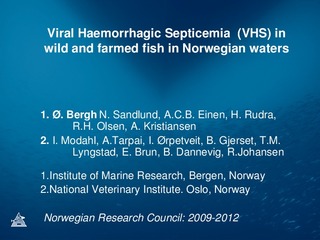Viral Haemorrhagic Septicemia (VHS) in wild and farmed fish in Norwegian waters
Bergh, Øivind; Sandlund, Nina; Einen, Ann Cathrine Bårdsgjære; Rudra, Hari; Olsen, Rolf Hetlelid; Kristiansen, Arve
Abstract
Viral Haemorrhagic septicaemia viruses (VHSV) are isolated
from 82 different fish species and are globally spread in
freshwater as well as marine environments. The virus can
cause disease outbreaks both in wild and farmed fish.
Different genotypes of the virus have been isolated in
different parts of the world. Furthermore, most isolates
seem to show some degree of species specificity. For
instance, the genotype 1a, that is a major killer in farmed
rainbow trout, shows low mortality to cod, and vice versa
the genotype III from cod show low mortality to rainbow
trout.
However, the established view was challenged in
2007, when a VHSV of genotype III resulted in a VHS outbreak
on several sites with farmed rainbow in one fjord in Norway.
The farmed populations were slaughtered, according to
legislative regulation. Experimental challenge studies
confirmed that this genotype III isolate showed higher
morality rates compared to other genotype III isolates. The
source of infection is still unknown, but wild reservoirs
are suspected.
A major aim is to investigate wild fish
along the Norwegian cost for detection of VHSV. New isolates
will be characterized and further investigated along with
the genotype III isolated from 2007. So far we have tested
almost 3000 fish from 36 different fish species. Results
from the screening and tentative challenge trials will be
presented.
